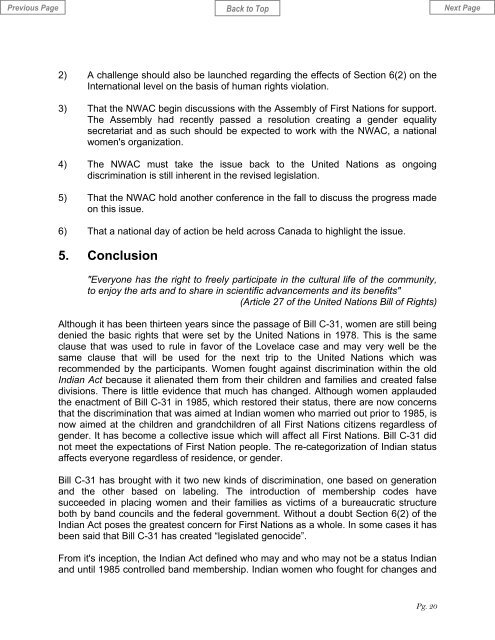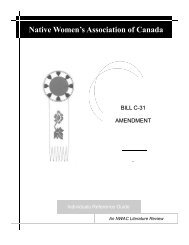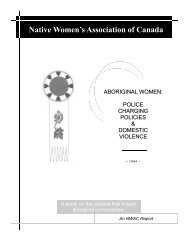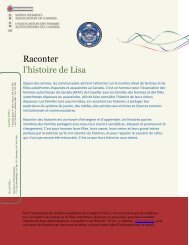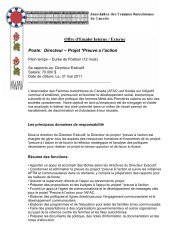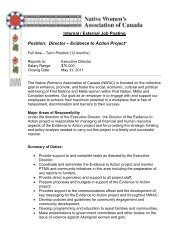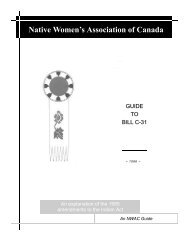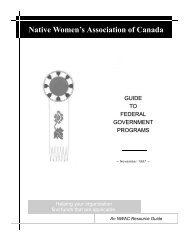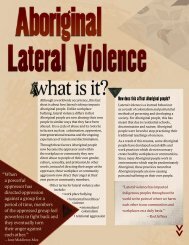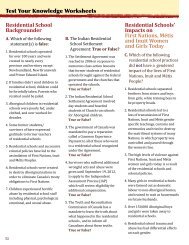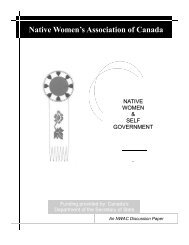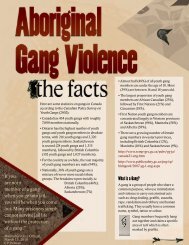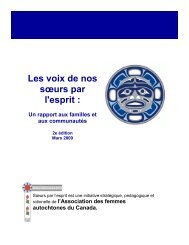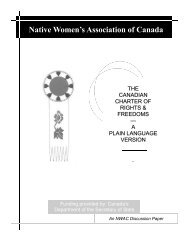BILL C-31 - Native Women's Association of Canada Website
BILL C-31 - Native Women's Association of Canada Website
BILL C-31 - Native Women's Association of Canada Website
- No tags were found...
Create successful ePaper yourself
Turn your PDF publications into a flip-book with our unique Google optimized e-Paper software.
2) A challenge should also be launched regarding the effects <strong>of</strong> Section 6(2) on theInternational level on the basis <strong>of</strong> human rights violation.3) That the NWAC begin discussions with the Assembly <strong>of</strong> First Nations for support.The Assembly had recently passed a resolution creating a gender equalitysecretariat and as such should be expected to work with the NWAC, a nationalwomen's organization.4) The NWAC must take the issue back to the United Nations as ongoingdiscrimination is still inherent in the revised legislation.5) That the NWAC hold another conference in the fall to discuss the progress madeon this issue.6) That a national day <strong>of</strong> action be held across <strong>Canada</strong> to highlight the issue.5. Conclusion"Everyone has the right to freely participate in the cultural life <strong>of</strong> the community,to enjoy the arts and to share in scientific advancements and its benefits"(Article 27 <strong>of</strong> the United Nations Bill <strong>of</strong> Rights)Although it has been thirteen years since the passage <strong>of</strong> Bill C-<strong>31</strong>, women are still beingdenied the basic rights that were set by the United Nations in 1978. This is the sameclause that was used to rule in favor <strong>of</strong> the Lovelace case and may very well be thesame clause that will be used for the next trip to the United Nations which wasrecommended by the participants. Women fought against discrimination within the oldIndian Act because it alienated them from their children and families and created falsedivisions. There is little evidence that much has changed. Although women applaudedthe enactment <strong>of</strong> Bill C-<strong>31</strong> in 1985, which restored their status, there are now concernsthat the discrimination that was aimed at Indian women who married out prior to 1985, isnow aimed at the children and grandchildren <strong>of</strong> all First Nations citizens regardless <strong>of</strong>gender. It has become a collective issue which will affect all First Nations. Bill C-<strong>31</strong> didnot meet the expectations <strong>of</strong> First Nation people. The re-categorization <strong>of</strong> Indian statusaffects everyone regardless <strong>of</strong> residence, or gender.Bill C-<strong>31</strong> has brought with it two new kinds <strong>of</strong> discrimination, one based on generationand the other based on labeling. The introduction <strong>of</strong> membership codes havesucceeded in placing women and their families as victims <strong>of</strong> a bureaucratic structureboth by band councils and the federal government. Without a doubt Section 6(2) <strong>of</strong> theIndian Act poses the greatest concern for First Nations as a whole. In some cases it hasbeen said that Bill C-<strong>31</strong> has created “legislated genocide”.From it's inception, the Indian Act defined who may and who may not be a status Indianand until 1985 controlled band membership. Indian women who fought for changes andPg. 20


